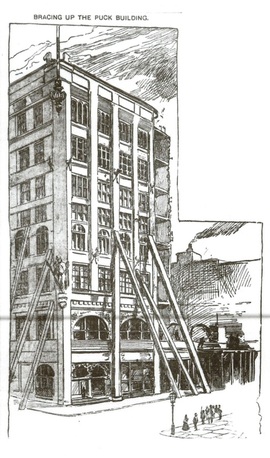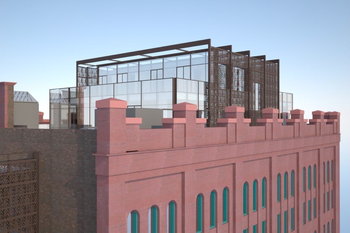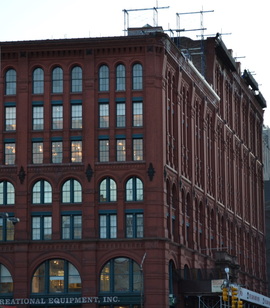| The Puck Building, 1897 as it is being braced during razing. (The World, 30 September 1897) | PUCK HISTORY The Puck Building, named after the famous character in Shakespeare’s Midsummer Night’s Dream, was built between 1885-86 by Jacob Ottoman. The crenelations and eyebrows over the multiple arched windows of the German Romanesque Revival styled building are as enchanting as the character “Puck.” Henry Bunner the editor of the weekly magazine, “Puck” which began about 1876, later moved to the building which became its namesake. The publication sparkled with political wit, poked fun at those in the limelight and claims to have helped develop the careers of world renowned figures including Mark Twain and Thomas Edison. The building was once the world’s largest center for printing and lithography. But it suffered the pain of tragedy and change from the start. Shortly after completion in 1886 it was threatened with having forty feet shaved off to make way for Elm Street (now Lafayette) which otherwise would have run straight through the building. A few years later several of the top floors were gutted by fire. Through the years it has been the scene of payroll robberies, elevator accidents, and the suicide of an unidentified man who hung himself on the roof just near the Puck statue. Shortly after the building’s tenth birthday, pedestrians feared for “life and limb” as bricks fell randomly during the razing of two-thirds of the building. Of even greater concern was the possibility that the building would collapse. In the early 1900s the weekly magazine became defunct after Hearst Publications, the new owner, disbanded it. The building, after having been closed for many years, was re-opened in 1983 and currently houses commercial space as well ballrooms for events such as weddings, meetings, trade shows, and dinners. |
SHAKESPEARE DRAMA IN THE 21ST CENTURY
The Puck Building is susceptible to the winds of change once again. Jared Kushner, (aka Ivanka Trump’s husband) awaits the decision of the board on the morning of November 15th. This is the third time he has applied to alter the existing structure with a rooftop addition that bears little resemblance to the original structure adorned with beautiful crenelations, arches, and detail work. During the original presentation several months prior, Jared passionately extolled his love for the building and his architect interjected the story of “Puck” for a dramatic affect. I imagine that the Kushner team was hoping that three times would be the charm, as the saying goes, but the results of the hearing proved that rule fallible. Despite the architect’s gentle modification of the structure, the board was not impressed enough to accept what they considered a massive, visible addition. They were even less affected by the waving of arms and wiggling of fingers in an expressive story-telling fashion by Sherida Paulsen, the architect, as she described how her father had given her a book of the Shakespearean comedy. They remained focused on the enormity and visibility of the addition with the concern that more attention would be drawn to the new attachment rather than to the building itself. One board member commented that while the story of Puck and its relation to the design is interesting, the average person walking on the street would not be thinking about that when they saw the monstrosity atop the building. “Perhaps I am romantically challenged,” he added. After questions were answered and deliberation among the members was completed with no action taken, a parting remark of, “See you…again…soon,” indicates that this is not the end of the Puck Building saga.



 RSS Feed
RSS Feed